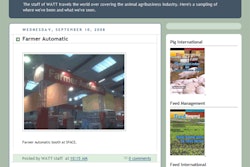The International Egg Commission recently circulated a study prepared by Dr. Adrian G. Williams of Cranfied University, Sisloe, United Kingdom (U.K.), on the environmental burden associated with various agricultural and livestock products. The study was funded by the Department for Environment, Food and Rural Affairs (DEFRA), the U.K. equivalent of the United States Department of Agriculture and is designated Public Report IS0205 dated August 5, 2006, available on www.defra.gov.uk/science.
Table: Comparison of the efficiency and environmental impact of alternative egg production systems
Environmental burdens
Dr. Williams developed a model to describe the environmental burdens and resources required to produce ten commodities applying the principles of Life Cycle Assessment. All relevant inputs into farm production for each commodity were traced back to primary sources.
Production activities including expenditure of fuel, feed production and processing were incorporated into the model. Emissions including carbon dioxide and nitrous oxide were quantified to determine the impact on global warming, eutrophication and acidification.
Lower energy requirement
Eggs had a lower primary energy requirement than hogs or red meat and were only slightly inferior to poultry meat. Egg production is associated with significantly lower global warming potential based on emissions and a correspondingly lower potential for eutrophication based on the liberation of phosphate.
The model incorporated assumptions relevant to the U.K. Their domestic egg industry comprises 66 percent non-organic production in cages, 27 percent non-organic production in floor housing and 1 percent raised according to organic standards.
Alternative systems
The comparisons among alternative egg production systems were based on 20,000 eggs. The significant values derived from the model are indicated in the accompanying table.
Free-range production required a considerably larger land area and was impacted adversely by lower feed conversion efficiency compared to caged hens.
Lower impact from free-range
The global warming potential from caged hens was lower than from free-range hens and organic production was inferior to conventional management and feeding.
Organic egg production requires 14 percent more energy than conventional systems and imposes an environmental burden 10 percent to 30 percent higher than non-organic production. Similarly, caged systems are more efficient in terms of energy conservation than free-range housing.
















